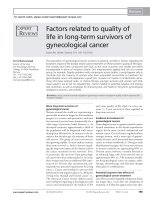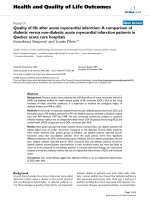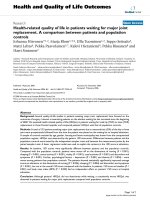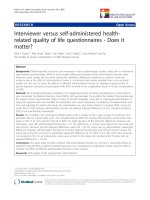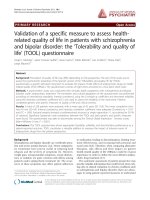Factors influencing health-related quality of life after total hip replacement - a comparison of data from the Swedish and Danish hip arthroplasty registers
Bạn đang xem bản rút gọn của tài liệu. Xem và tải ngay bản đầy đủ của tài liệu tại đây (363.05 KB, 6 trang )
Gordon et al. BMC Musculoskeletal Disorders 2013, 14:316
/>
RESEARCH ARTICLE
Open Access
Factors influencing health-related quality of life
after total hip replacement - a comparison of data
from the Swedish and Danish hip arthroplasty
registers
Max Gordon1,2, Aksel Paulsen3, Søren Overgaard3,4, Göran Garellick1,5, Alma B Pedersen6 and Ola Rolfson1,5*
Abstract
Background: There is an increasing focus on measuring patient-reported outcomes (PROs) as part of routine
medical practice, particularly in fields such as joint replacement surgery where pain relief and improvement in
health-related quality of life (HRQoL) are primary outcomes. Between-country comparisons of PROs may present
difficulties due to cultural differences and differences in the provision of health care. However, in order to understand
how these differences affect PROs, common predictors for poor and good outcomes need to be investigated. This
cross-sectional study investigates factors influencing health-related quality of life (HRQoL) one year after total hip
replacement (THR) surgery in Sweden and in Denmark.
Methods: Data was retrieved from the Swedish (n = 14 560 patients) and Danish (n = 632 patients) Hip Arthroplasty
Registers according to preset selection criteria. Using linear regression models, we examined how sex, age, comorbidity
and country of surgery were associated with different aspects of HRQoL as measured by the EQ-5D index and EQ VAS.
Results: Danish patients had an overall higher EQ-5D index and EQ VAS than Swedish patients (p < 0.001). After
regression analysis, the estimated coefficients for sex, age, or the Charlson score did not differ between countries for
either the EQ-5D index (p = 0.83) or EQ VAS (p = 0.41) one year after THR.
Conclusions: We conclude that there are clear similarities in how basic predictors influence patient-reported outcomes
(PROs) in patients with THR in Sweden and Denmark and these known predictors of good or poor HRQoL outcomes
are not specific for each country.
Keywords: Total hip replacement, EQ-5D, Predictors, Comorbidity, Patient-reported outcome, Patient-reported
outcome measures, Register study
Background
There is an increasing focus on measuring patientreported outcomes (PROs) as part of routine medical
practice, particularly in fields such as joint replacement
surgery where pain relief and improvement in healthrelated quality of life (HRQoL) are primary outcomes.
Implant survival, radiographic success and absence of
adverse events do not guarantee good results from a
* Correspondence:
1
Swedish Hip Arthroplasty Register, Gothenburg, Sweden
5
Department of Orthopaedics, Institute of Clinical Sciences, The Sahlgrenska
Academy, University of Gothenburg, Gothenburg, Sweden
Full list of author information is available at the end of the article
patient’s perspective. A commonly used instrument to
measure patient-reported health outcomes is the EQ-5D,
introduced by the EuroQol group in 1987. Health
outcomes according to EQ-5D have been found to differ
between European countries, calling for caution when
making international comparisons of disease burden and
health care effectiveness [1]. However, the differences in
the EQ-5D index have been found to be rather small regardless of valuation method. Despite between-country
variations in the EQ-5D index, the associations between
age and sex and EQ-5D index was the same for all countries [2].
© 2013 Gordon et al.; licensee BioMed Central Ltd. This is an open access article distributed under the terms of the Creative
Commons Attribution License ( which permits unrestricted use, distribution, and
reproduction in any medium, provided the original work is properly cited.
Gordon et al. BMC Musculoskeletal Disorders 2013, 14:316
/>
Page 2 of 6
National registry data play an essential role in monitoring, developing and improving joint replacement
surgery [3]. PRO measures are routinely collected for
all patients undergoing total hip replacement (THR) in
Sweden by the Swedish Hip Arthroplasty Register
(SHAR) [4]. In Denmark, occasional cross-sectional
collections of PROMs have been accomplished by the
Danish Hip Arthroplasty Register (DHR) in random
samples of the Danish THR population. Close collaboration through the Nordic Arthroplasty Register Association allows not only for pooling and comparisons of
national implant survival data, but also for analyses of
PROs.
The objective of this study was to investigate factors
predicting the level of HRQoL one year after THR in patients operated on in Denmark and Sweden. In particular we examined how sex, age, comorbidity and country
of surgery were associated with the EQ-5D index and
EQ VAS after surgery. We also investigated the external
validity of the results by comparing the associated variables between the two countries.
Methods
Study population
SHAR, started in 1979, and DHR, started in 1995, gather
prospective observational nationwide data. All public
and private orthopaedic departments performing THR
in Sweden and Denmark report to the respective register. As part of a routine follow-up program, SHAR has
been collecting EQ-5D data since 2002. DHR has collected EQ-5D data from a random subset of patients operated in 1999, 2004 and 2008 [5].
For these analyses we selected THRs due to primary
osteoarthritis. From SHAR all patients operated in
2006 and 2007 and from DHR all patients operated in
2008 with complete one year EQ-5D data were included. Patients re-operated within a year, or with
missing values in any of the outcome scores were excluded from the analysis. For bilateral cases the first
operation was selected.
Comorbidity profiles were estimated by cross-matching
data with the Swedish National Patient Register and the
Danish National Registry of Patients. Both Sweden and
Denmark have unique personal identification numbers
allowing a perfect match between registers. The disparity
in the choice of year for surgery was due to lack of comorbidity data from the Swedish National Patient Register at
the time the databases were merged. With these selection
criteria we identified 14 560 Swedish patients and 632
Danish patients.
Outcomes variables
Patients selected for this study had completed a one year
follow-up EQ-5D questionnaire sent via ordinary mail.
The EQ-5D evaluates subjects in five HRQoL dimensions, namely mobility, self-care, usual activities, pain/
discomfort and anxiety/depression [6,7]. In this version
of the EQ-5D instrument (EQ-5D-3L) each dimension is
divided into three levels of graded severity generating
243 possible response combinations. The EQ-5D can be
presented as a global health index with a weighted total
value for HRQoL. Due to the lack of a specific Swedish
EQ-5D tariff the Danish TTO tariff [8] was used for all
patients, ranging from −0.624 to 1, where 1 represents
the best possible health state. The EQ-5D also contains
a health state visual analogue scale (EQ VAS) ranging
from 0, worst imaginable health state, to 100, best imaginable health state.
The primary outcomes were the EQ-5D index and EQ
VAS one year after THR. Median time from surgery to
follow-up was 1.1 years (range 0.9-1.9) for the Swedish
population and 1.2 years (range 0.9-1.5) for the Danish
population.
Table 1 Characteristics of Swedish and Danish patients
Variable
Denmark
Sweden
Danish reference THR population
Swedish reference THR population
Male sex
40.5% (256)
42.2% (6148)
43.8% (2579)
43.1% (10 182)
Age
68.5 (± 10.1)
69.4 (± 9.6)
69.1 (± 9.8)
68.6 (± 10.3)
Right side
54.6% (345)
56.1% (8174)
53.3% (3162)
55.5% (13 102)
2008.3 (± 0.2)
2007.0 (± 0.6)
(2008)
(2006–2007)
Year of surgery
Charlson score
Low
91.0% (575)
86.3% (12 561)
89.7% (5318)
86.8% (20 481)
Medium (1–2)
8.4% (53)
12.8% (1859)
9.4% (557)
12.2% (2888)
High (> 2)
0.6% (4)
1.0% (140)
1.0% (56)
1.0% (249)
Outcomes
EQ-5D
0.85 (± 0.19)
0.81 (± 0.19)
-
-
EQ-5D VAS
81.6 (± 19.5)
75.5 (± 20.4)
-
-
Data are presented as percentages (number of patients) for proportional variables, while continuous variables are mean ±SD.
Gordon et al. BMC Musculoskeletal Disorders 2013, 14:316
/>
Page 3 of 6
Table 2 Comparison of EQ-5D dimensions between Swedish and Danish patients
Dimensions
Denmark
Sweden
P-value
No problems
79% (502)
59% (8603)
< 0.001
Some problems
20% (129)
41% (5934)
Confined to bed
0% (1)
0% (20)
No problems
88% (553)
91% (13 273)
Some problems
12% (74)
8% (1187)
1% (5)
1% (96)
No problems
63% (397)
76% (10 997)
Some problems
34% (212)
22% (3202)
4% (23)
2% (360)
None
64% (406)
43% (6224)
Moderate
33% (208)
53% (7662)
Extreme
3% (18)
5% (669)
None
87% (549)
77% (11 200)
Moderate
11% (71)
22% (3156)
Extreme
2% (12)
1% (199)
Mobility
Statistical methods
Self-care
Unable
0.0065
Usual activities
Unable
score estimation [10] from hospitalizations one year prior
to surgery (including surgery hospitalization). Patients
were categorized by three levels: low (no recorded previous diseases), medium (1–2 points) and high (>2 points).
< 0.001
Pain/discomfort
< 0.001
We used linear regression models to study the association
between independent predictors and the dependent variables EQ-5D index and EQ VAS score. The regression coefficients were calculated with 95% confidence intervals,
which were used to describe statistical significance of association. Age was investigated by a restricted cubic spline
to avoid residual confounding for the comorbidity variables. The number of knots on the spline curve was
chosen by selecting the model with the lowest Akaike information criterion [11]. Effect modification for country
was evaluated by ANOVA (analysis of variance).
All analyses where performed using R version 3.0.1,
and the rms package (v 4.0-0). Due to non-normal distributed outcomes with heteroscedasticity the confidence
intervals were calculated by using a robust covariance
matrix (HC3) [12,13].
Anxiety/depression
< 0.001
Data are presented as percentages (number of patients) and p-values are
derived from Fischer’s exact test.
Independent variables
As independent possible predictors we investigated country, age at surgery, sex, and comorbidity as measured by
the Charlson comorbidity score. The Charlson comorbidity score is a prospectively applicable method for classifying co-morbid conditions which might alter the risk of
mortality. The Charlson score has 17 disease categories,
selected and weighted on the basis of the strength of
their association with mortality [9]. It is readily applicable in registry research and we used ICD-10 codes
(International Classification of Diseases version 10) for
Ethical approval
Ethical review approval was obtained from the Central
Ethical Review Board in Gothenburg for the merger of
the SHAR with the Swedish National Patient Register
(decision 328–08) databases, and by amendment the
merging of the populations from SHAR and DHR (decision T210-12). The merger of the DHR and Danish
National Registry of Patients was approved by the
Danish Data Protection Agency (2010-41-5103 and
2013-41-1445).
Results
Demography
As presented in Table 1, the demography and comorbidity burden was similar in the two populations. There
were no or minor disparities in the demography and comorbidity burden compared to the THR populations
Figure 1 Comparison of factors influencing EQ-5D index between Swedish and Danish patients. Forest plot with 95% confidence intervals
for the estimates of EQ-5D index one year after THR for gender (reference=female), age 85 years (reference=65 years), and medium or high
Charlson (reference=low Charlson) for Swedish (blue) and Danish (red) patients.
Gordon et al. BMC Musculoskeletal Disorders 2013, 14:316
/>
Page 4 of 6
Figure 2 Comparison of factors influencing EQ VAS between Swedish and Danish patients. Forest plot with 95% confidence intervals for
the estimates of EQ VAS one year after THR for gender (reference=female), age 85 years (reference=65 years), and medium or high Charlson
(reference=low Charlson) for Swedish (blue) and Danish (red) patients.
with primary osteoarthritis during corresponding time
periods (Table 1).
Main results - comparison between countries
Danish patients had an overall higher EQ-5D index and
EQ VAS than Swedish patients (p < 0.001). The distribution of answers in the five EQ-5D dimensions significantly (all p < 0.001) differed between countries; Danish
patients scored higher for the mobility, pain/discomfort,
and anxiety/depression qualities, while Danish patients
scored lower in the usual activities dimension (Table 2).
There was no difference between the countries in how
sex, age or the Charlson comorbidity index affected the
EQ-5D index (p = 0.83) or EQ VAS (p = 0.41) one year
after hip replacement (Figures 1 and 2).
Other results - identification of overall predictors for PRO
Male patients reported higher EQ-5D indexes and EQ
VAS scores than females. Patients with a medium or
high Charlson comorbidity index at the time of primary
THR surgery reported poorer outcomes for the EQ-5D
index and EQ VAS compared to patients with low
Charlson comorbidity index (Tables 3 and 4). Age behaved in a non-linear pattern, peaking at around 65 years
(Figures 3 and 4).
fundamental prerequisite for understanding how to meet
the changes in demands on joint replacement surgery is to
measure outcomes from a patient perspective. PROMs are
becoming increasingly important in the allocation of health
care resources and the provision of guidelines for optimum
care and management [14]. Large variations between and
within countries in disease severity when deciding to operate have been reported [15]. How these variations affect
the PROs is sparsely explored. Therefore, in order to compare PROs between countries, these common covariates
need to be investigated and compared.
Why Danish patients report higher HRQoL one year
postoperatively than Swedish is a question requiring
consideration. Firstly, population studies have shown
that Danish people in general perceive their HRQoL to
be higher than Swedes do [16,17]. Thus, the assumption
that EQ-5D values for Danish patients at any time-point
are higher than for Swedish patients, would partly explain the observed difference. Secondly, differences in
fixation method, implants used and surgical technique
may play a role for the PROs. Exempli gratia, the
Table 3 Association between possible independent
predictors and the mean value of EQ-5D index
Variable
Discussion
In this study of patients with THR in Denmark and
Sweden, we found no significant differences in how age,
sex and comorbidity status influence the level of HRQoL
one year after surgery. The consistency of these common
and basic predictors facilitates pooling and comparisons of
data and interpretation of results from the two countries.
Intercept
Continual development in joint replacement surgery, continual progresses in medicine, and longer life expectancy,
have led to increasing demands for joint replacements.
Today there are numerous long-term reports documenting
the outstanding survival of many implant designs. One
Adjusted
2.5% to 97.5%
Coef
2.5% to 97.5%
0.815
0.812 to 0.818
0.800
0.759 to 0.841
0
ref
0
ref
Sex
Male
Female
−0.042 −0.048 to −0.036 −0.040 −0.046 to −0.034
Charlson’s index
Low
Comparisons between countries
Crude
Coef
0
ref
0
ref
Medium (1–2)
−0.043 −0.052 to −0.034 −0.039
High (> 2)
−0.093 −0.123 to −0.062 −0.092 −0.123 to −0.062
−0.048 to −0.030
Denmark
Country = Sweden −0.041 −0.056 to −0.026 −0.039 −0.054 to −0.024
Adjusted results refer to the full model with all predictors in the table and the
spline for age.
Gordon et al. BMC Musculoskeletal Disorders 2013, 14:316
/>
Page 5 of 6
Table 4 Association between possible independent
predictors and the mean value of EQ VAS
Variable
Intercept
Crude
Adjusted
Coef 2.5% to 97.5%
Coef 2.5% to 97.5%
75.7
75.4 to 76.0
77.5
72.9 to 82.1
0
ref
0
ref
−2.7
−3.4 to −2.1
−2.4
−3.1 to −1.8
Sex
Male
Female
Charlson’s index
Low
0
ref
0
ref
Medium (1–2)
−5.8
−6.8 to −4.8
−5.1
−6.1 to −4.1
High (> 2)
−13.8
−17.1 to −10.5
−13.1
−16.8 to −9.3
−6.1
−7.7 to −4.4
−5.7
−7.2 to −4.1
Denmark
Country = Sweden
Adjusted results refer to the full model with the predictors in the table and
the spline for age.
posterior approach is more common in Denmark and
previous work indicates that a posterior approach is associated with better PROs as compared to the direct lateral approach [18,19]. Thirdly, the difference in mean
age at surgery indicates that Danish patients have
surgery at an earlier stage of hip disease. Although age is
included in the regression model, there may be residual
confounding due to age being a proxy for stage of hip
disease. Surgery at an earlier stage of disease implies a
preservation of HRQoL after hip replacement. Conversely,
surgery at a late stage of disease may reduce the possibility
of reaching the expected level of HRQoL for the particular
age group. We do not believe the difference in recruitment
years explains the observed difference. This view is
Figure 4 The age as a spline for EQ VAS. The spline is adjusted
for sex = female, Charlson score = low, and country = Sweden.
supported by the consistency in the EQ-5D index over
time in the Swedish THR population.
Age as a predictor
The one-year level of EQ-5D index peaks at about 65 to
70 years. The gradual decline in ages above 70 could be
explained by the overall age-dependent abatement seen
in the general population. However, the youngest patients did not reach the expected level of EQ-5D. Our
interpretation is that younger patients have more active
lifestyles and are more likely to be hampered by the limitations of their hip disease, and subsequently their artificial joint, than older patients. The lower mean EQ-5D
index in younger patients suggests room for improvement in the way these patients are managed. In order to
preserve as much HRQoL as possible among younger
patients, persevering with non-surgical treatment options is important. However, it might reasonably be argued that they should have surgery at an earlier stage,
and yet the risk of revision complicates this analysis.
Methodological considerations
Figure 3 The age as a spline for EQ-5D index. The spline is adjusted
for sex = female, Charlson score = low, and country = Sweden.
The large study population combining a nationwide
Swedish THR population and a randomly selected nationwide Danish THR population contributes to the
strength of this study. Reoperations have been excluded
which limits the effect of potential confounders related
to implant survival.
The cross-sectional nature of the study limits comparisons of outcomes between the two countries and few
variables have been included in the models. Preoperative
PROMs were not available for the Danish patients and
Gordon et al. BMC Musculoskeletal Disorders 2013, 14:316
/>
thus comparisons taking baseline levels into account
were not possible. Furthermore, the Danish population
was much smaller than the Swedish and chance may
affect Danish data to a greater extent than Swedish.
Including a larger Danish population may have resulted
in significant differences between countries in how the
investigated predictors affect the outcomes. However,
the clinical relevance of such small differences would, in
that case, be questioned.
Conclusions
There are clear similarities in how basic predictors influence patient-reported outcomes in patients with THR in
Sweden and Denmark. Apparent cultural, social and other
such differences among these countries are not reflected
in these predictors. However, Danish THR patients exhibit
a significantly higher HRQoL one year after surgery compared to Swedish patients. This difference will be subject
to further analyses of prospective data.
Abbreviations
DHR: Danish Hip Arthroplasty Register; HRQoL: Health-Related Quality of Life;
PRO: Patient-Reported Outcome; PROM: Patient-Reported Outcome Measure;
SHAR: Swedish Hip Arthroplasty Register; THR: Total Hip Replacement.
Competing interests
MG has no competing interests.
AP has no competing interests.
SO is the director of the Danish Hip Arthroplasty Register.
GG is the director of the Swedish Hip Arthroplasty Register at the Centre of
Registers in Region Västra Götaland.
ABP has no competing interests.
OR is partly employed by the Swedish Hip Arthroplasty Register at the
Centre of Registers in Region Västra Götaland.
Authors’ contributions
MG participated in the design of the study, prepared and merged the
databases, carried out the statistical analyses, and contributed to drafting the
manuscript. AP participated in the design of the study, managed ethical review
board approval in Denmark, and revised the manuscript. SO participated in the
design of the study and revised the manuscript. GG participated in the design
of the study and was responsible for the acquisition of Swedish data. ABP
participated in the design of the study, was responsible for the acquisition of
Danish data and revised the manuscript. OR participated in the design of the
study, managed ethical review board approval in Sweden and was responsible
for drafting the manuscript. All authors read and approved the final manuscript.
Acknowledgements
The authors would like to thank Mark Rosenfeld, Rosenfeld Waltbrand AB
and Magdalena Kay, associate professor at the department for English,
University of Victoria for language editing. The study was funded by the
Swedish Hip Arthroplasty Register and the Danish Hip Arthroplasty Register.
Author details
1
Swedish Hip Arthroplasty Register, Gothenburg, Sweden. 2Division of
Orthopaedics, Department of Clinical Sciences at Danderyd Hospital,
Karolinska Institute, Danderyds Sjukhus, Sweden. 3Department of
Orthopaedic Surgery and Traumatology, Odense University Hospital,
University of Southern Denmark, Odense, Denmark. 4Danish Hip Arthroplasty
Register, Odense, Denmark. 5Department of Orthopaedics, Institute of Clinical
Sciences, The Sahlgrenska Academy, University of Gothenburg, Gothenburg,
Sweden. 6Department of Clinical Epidemiology, Aarhus University Hospital,
Aarhus, Denmark.
Page 6 of 6
Received: 18 February 2013 Accepted: 31 October 2013
Published: 6 November 2013
References
1. Konig HH, Bernert S, Angermeyer MC, Matschinger H, Martinez M, Vilagut G,
Haro JM, de Girolamo G, de Graaf R, Kovess V, et al: Comparison of
population health status in six european countries: results of a
representative survey using the EQ-5D questionnaire. Med Care 2009,
47(2):255–261.
2. Bernert S, Fernandez A, Haro JM, Konig HH, Alonso J, Vilagut G, SevillaDedieu C, de Graaf R, Matschinger H, Heider D, et al: Comparison of different valuation methods for population health status measured by the
EQ-5D in three European countries. Value Health 2009,
12(5):750–758.
3. Malchau H, Garellick G, Eisler T, Karrholm J, Herberts P: Presidential guest
address: the Swedish Hip Registry: increasing the sensitivity by patient
outcome data. Clin Orthop Relat Res 2005, 441:19–29.
4. Rolfson O, Dahlberg LE, Kärrholm J, Garellick G: Patient-reported outcomes
in the Swedish Hip Arthroplasty Register. J Bone Joint Surg Br 2011, 93-B
(7):867–875.
5. Paulsen A, Pedersen AB, Overgaard S, Roos EM: Feasibility of 4 patientreported outcome measures in a registry setting. Acta Orthop 2012,
83(4):321–327.
6. EuroQol: The EuroQol Group: EuroQol - a new facility for the measurement of health related quality of life. Health Policy 1990, 16(3):10.
7. Carr-Hill RA: Health related quality of life measurement–Euro style. Health
Policy 1992, 20(3):321–328. discussion 329–332.
8. Wittrup-Jensen KU, Lauridsen J, Gudex C, Pedersen KM: Generation of a
Danish TTO value set for EQ-5D health states. Scand J Public Health 2009,
37(5):459–466.
9. Charlson ME, Pompei P, Ales KL, MacKenzie CR: A new method of
classifying prognostic comorbidity in longitudinal studies: development
and validation. J Chronic Dis 1987, 40(5):373–383.
10. Quan H, Sundararajan V, Halfon P, Fong A, Burnand B, Luthi JC, Saunders
LD, Beck CA, Feasby TE, Ghali WA: Coding algorithms for defining
comorbidities in ICD-9-CM and ICD-10 administrative data. Med Care
2005, 43(11):1130–1139.
11. Harrell FE: Regression Modeling Strategies: With Applications to Linear Models,
Logistic Regression, and Survival Analysis. New York: Springer; 2010.
12. Long JS, Ervin LH: Using heteroscedasticity consistent standard errors in
the linear regression model. Am Stat 2000, 54(3):217–224.
13. Burström K, Johannesson M, Diderichsen F: A comparison of individual
and social time trade-off values for health states in the general population. Health Policy 2006, 76(3):359–370.
14. Devlin NJ, Appleby J: Getting the most out of PROMs. Putting health outcomes
at the heart of NHS decision-making. London: The King’s Fund; 2010.
15. Dieppe P, Judge A, Williams S, Ikwueke I, Guenther KP, Floeren M, Huber J,
Ingvarsson T, Learmonth I, Lohmander LS, et al: Variations in the preoperative status of patients coming to primary hip replacement for
osteoarthritis in European orthopaedic centres. BMC Musculoskelet Disord
2009, 10:19.
16. Burstrom K, Johannesson M, Diderichsen F: Swedish population healthrelated quality of life results using the EQ-5D. Qual Life Res 2001,
10(7):621–635.
17. Sorensen J, Davidsen M, Gudex C, Pedersen KM, Bronnum-Hansen H:
Danish EQ-5D population norms. Scand J Public Health 2009,
37(5):467–474.
18. Smith AJ, Wylde V, Berstock JR, Maclean AD, Blom AW: Surgical approach
and patient-reported outcomes after total hip replacement. Hip Int 2012,
22(4):355–361.
19. Garellick G, Kärrholm J, Rogmark C, Rolfson O, Herberts P: Swedish Hip
Arthroplasty Register Annual Report 2011. In Swedish Hip Arthroplasty
Register Annual Report 2011, vol. 2011. 1st edition. Edited by Garellick G,
Kärrholm J, Rogmark C, Rolfson O, Herberts P. Gothenburg: Swedish Hip
Arthroplasty Register; 2012.
doi:10.1186/1471-2474-14-316
Cite this article as: Gordon et al.: Factors influencing health-related
quality of life after total hip replacement - a comparison of data from
the Swedish and Danish hip arthroplasty registers. BMC Musculoskeletal
Disorders 2013 14:316.
